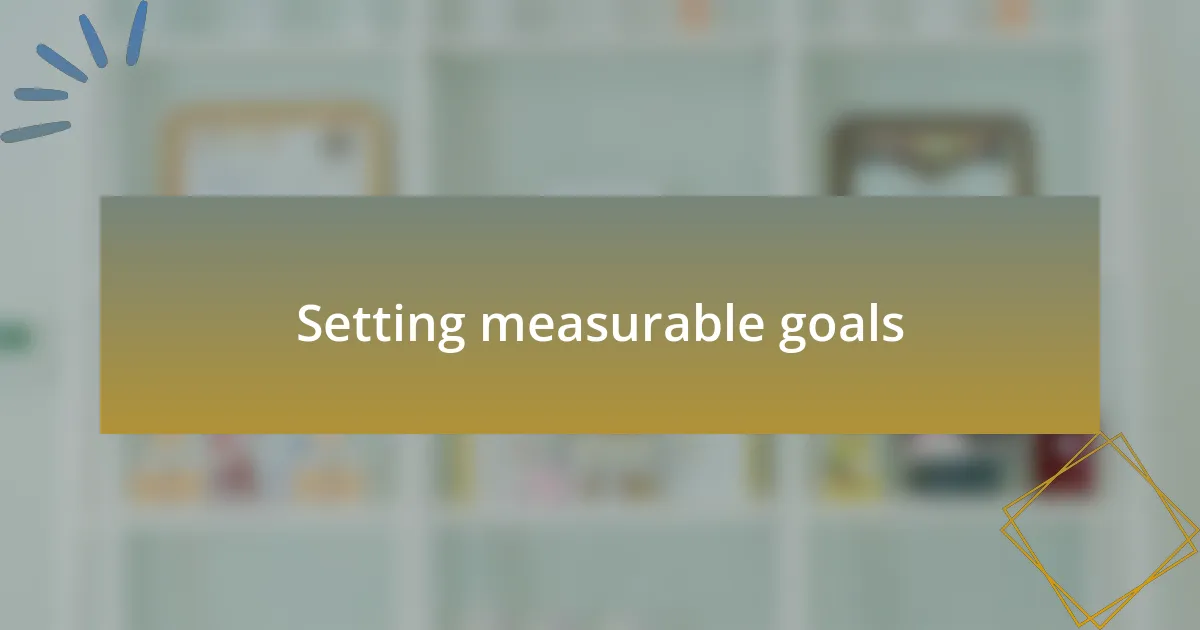Key takeaways:
- Understanding and tracking performance metrics is essential for improving website effectiveness and engaging with the audience.
- Tools like Google Analytics and social media analytics help identify trends and user preferences, shaping content strategies.
- Setting measurable and flexible goals allows for ongoing assessment and adaptation based on audience feedback and changing trends.
- Data analysis transforms numbers into narratives, highlighting the importance of genuine engagement over superficial metrics.

Understanding performance metrics
Performance metrics can often seem overwhelming, but understanding them is essential for evaluating the effectiveness of a website, especially one focused on Music Awards. For example, when I first started analyzing my site’s metrics, I was stunned by the sheer volume of data available, but slowly, it became clear how pivotal metrics like bounce rates and page views were to my site’s success.
Sometimes, I wonder how many website owners truly tap into the insights that performance metrics provide. For me, discovering the relationship between user engagement and time spent on the site was a game-changer. I remember feeling a rush of excitement when I noticed that certain award categories generated significantly longer visits, prompting me to delve deeper into what content resonated with my audience.
I can’t stress enough how important it is to regularly track and reflect on your performance metrics. It’s not just about numbers; it’s about understanding your audience’s preferences and behaviors. Each time I uncover a trend, it’s like piecing together a puzzle, providing me with clarity on how to enhance my content and engage more effectively with fellow music enthusiasts.
![]()
Importance of tracking metrics
While it may seem tedious at times, tracking performance metrics is crucial for pinpointing what truly resonates with your audience. I recall regularly checking my audience demographic metrics, and that data revealed surprising insights about who was engaging with my content. It wasn’t just music lovers; I discovered a growing interest from younger demographics, prompting me to tailor my posts to connect with them.
One stark realization I had was how metrics can directly influence strategic decisions. After noticing a significant drop in click-through rates on award nominations, I decided to revamp that section completely. The result? A surge in engagement that not only increased visits but also sparked lively discussions among my users.
At the end of the day, tracking metrics gives you a clearer understanding of your impact and potential growth. Isn’t it fascinating how a simple number can reflect a larger story about user behavior? Every time I analyze my site’s data, I see it as an opportunity—not just a task—helping me enhance user experience and foster a deeper community around the music awards I love.
![]()
Tools for tracking music metrics
When it comes to tracking music metrics, my go-to tools have been Google Analytics and SEMrush. Google Analytics was a game-changer for me; it provided a comprehensive view of how visitors navigated my site. I vividly remember the thrill of discovering which award shows generated the most buzz and how that data directly influenced my content strategy.
I also explored social media analytics tools like Hootsuite and Buffer, which offered insights into how my posts performed across various platforms. It was eye-opening to see how engagement would spike around certain nominations and performances. Have you ever experienced the rush of seeing a post go viral? It’s a testament to the importance of understanding what your audience craves.
Additionally, using tools like Spotify for Artists helped me gauge how my playlists and featured artists resonated with listeners. I often found myself captivated by the trends, watching how different genres or collaborations would suddenly gain traction. Isn’t it fascinating how the right tools can open up a whole new world of data, revealing hidden opportunities for growth?

Setting measurable goals
Setting measurable goals starts with clarity. I remember when I first outlined my objectives for the music awards site; I focused on specific metrics like increasing visitor engagement by 20% over six months. It felt daunting, but having a clear target transformed my approach to content creation. How else can you truly gauge success without a defined benchmark?
As I tracked my progress, I realized that breaking down my goals into smaller, actionable steps was key. For instance, instead of solely aiming for that 20% increase, I set monthly targets to monitor my performance. Each milestone I achieved, like a 5% boost in engagement, felt like a victory. Have you ever felt that sense of accomplishment when you reached a goal? It truly motivates you to keep pushing forward.
Finally, I learned that metrics should be dynamic, not static. I initially set my goals based on past performance, but as trends shifted, I had to adjust my targets accordingly. It’s incredibly important to remain flexible and responsive to your audience’s needs. By doing so, I felt more in tune with my readers, and it helped me stay ahead of the curve. Isn’t that a rewarding feeling—knowing you’re not just keeping up, but leading the conversation?
![]()
My personal tracking process
Once I established my measurable goals, I embarked on a structured tracking process that became a vital part of my routine. Every week, I set aside time to review key performance indicators like page views, user interactions, and bounce rates. At first, it felt overwhelming, but I quickly learned that consistency was my ally; it transformed tracking from a chore into a meaningful pursuit. Have you ever found joy in discovery through numbers? Each update revealed insights that prompted creativity in how I approached content.
In the beginning, I relied heavily on analytics tools to gather data. However, I found that merely looking at numbers wasn’t enough; understanding the story behind those numbers was essential. I started correlating spikes in traffic with specific content releases, like when I covered an artist’s surprise album drop. Those moments were exhilarating! It made me appreciate the real-time impact my work had on my audience. How often do you think about the narratives hidden within your metrics?
To keep myself engaged, I created a visual dashboard that displayed my progress. It was like a personal scoreboard! I incorporated colorful graphs and charts that tracked my growth. Seeing my engagement metrics rise over time added a layer of excitement to my work. Each upward trend felt like a cheer from the audience, pushing me to strive for even more. Do you think visuals can change the way we perceive our accomplishments? I certainly believe they can spark motivation and keep us focused on our goals.

Analyzing my performance data
When analyzing my performance data, I often found myself diving deep into the numbers to uncover patterns that were not immediately obvious. For instance, I once noted that certain periods of the year brought a surge in engagement, particularly around major music events like the Grammys. This discovery not only shaped my content strategy but also reignited my passion for connecting with my audience during those key moments. Have you ever experienced a similar revelation in your own work?
As I scrutinized my analytics, I realized that user interactions provided invaluable feedback on my content’s effectiveness. One specific insight was how comments on posts about new music releases sparked discussions that lasted days. This prompted me to refine my approach, focusing more on topics that encouraged dialogue. Isn’t it fascinating how numbers can translate into human connection?
Tracking my performance metrics became more than just a numbers game; it evolved into a form of storytelling. Each data point reflected not just a statistic, but a connection I had forged with my readers. I remember the thrill of hitting a milestone of 10,000 unique visitors in one month—an accomplishment that felt deeply validating. Do those moments resonate with you in your journey? Recognizing these successes fueled my drive to continuously improve and engage even more meaningfully in my niche.
![]()
Lessons learned from tracking
As I delved into my tracking data, one significant lesson was the importance of adapting quickly to audience feedback. For example, I once noticed that a specific music genre gained unexpected traction during a particular season, prompting me to pivot my content focus. Have you ever had to make a sudden shift based on unexpected insights? That experience taught me that flexibility is just as crucial as planning.
Another realization was the correlation between my posting frequency and audience engagement. I found that when I consistently posted around significant music events, engagement soared. It was almost as if I had tapped into a shared excitement that was brewing in my audience. Have you ever struck a chord with your audience just when they needed it? This taught me that timing is everything; being in sync with your community can amplify connection.
Moreover, I learned that not all metrics hold equal weight. While page views might look impressive, the real value lay in the time spent on a page and the depth of interaction. I vividly remember a piece I wrote that had lower page views but sparked heartfelt emails from readers, making me realize the true impact of genuine engagement. What metrics have you found most revealing in your own tracking journey? Recognizing the nuances behind the numbers has truly enriched my approach and understanding of my audience.